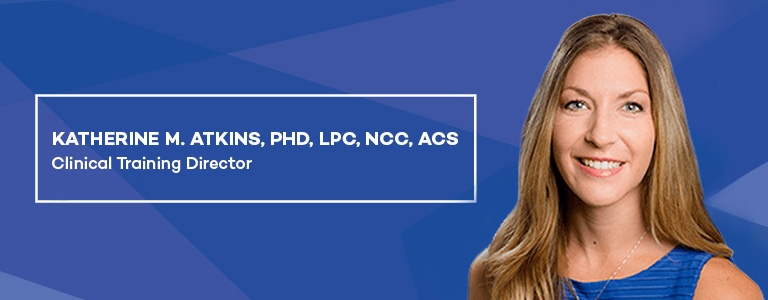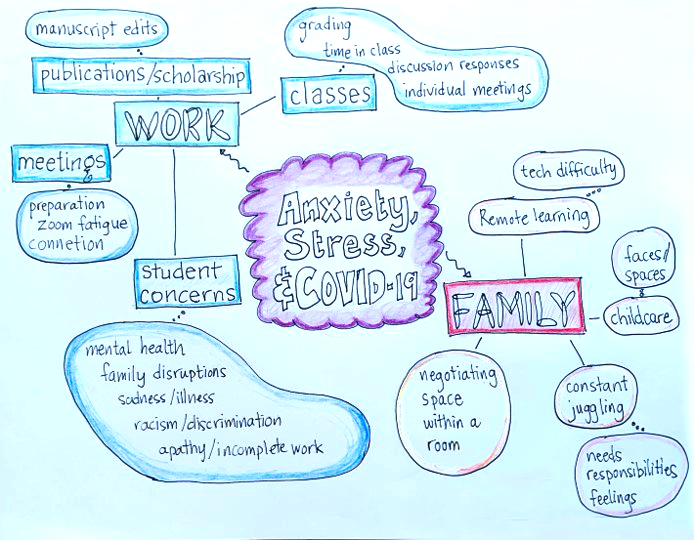Identifying Stressors Through Cognitive Mapping

Throughout the pandemic, I have found it helpful to draw out cognitive maps to visualize what I am experiencing. The idea of cognitive maps originates from the work of the psychologist Edward Tolman. Cognitive maps have a strong spatial connotation and are graphical representations of knowledge of concepts and the relationships between them. Typically, key elements of the map are concepts, which are placed into boxes, circles, or shapes to distinguish them, and relationships between concepts are usually in the form of labeled lines or directional arrows (see my map below).
To construct a cognitive map, consider your existing knowledge. It also helps to have a focus question. My most recent map focused on this question: What is currently adding to levels of stress and anxiety as they are related to COVID-19?
Next, identify key concepts and then rank them in order of importance. As I constructed my preliminary map, I considered work, family, self-care, balance, remote learning, the death of RBG, unknowns regarding the vaccine, and even my wishes of wanting to travel (I know, first world problems but still—travel is a major part of my life).
I broke my preliminary map down into two areas that I must prioritize: family and work. I wrote out various stressors and anxieties as they related to family and work on Post-It notes. Then, I identified the relationships between these concepts. It is important to note that as you work through some of these stressors and anxieties, you can review and revise your map and move things around.

I want to invite you to complete your own cognitive map.
The uncertainty that I deal with daily regarding school is a major stressor. Thus, I will begin with virtual learning. Those two words alone can be triggering for some. Perhaps you had a visceral reaction when you found out you or your children were slated to go back to school, or maybe that reaction was about remote learning. You likely entered problem-solver mode immediately and tried to figure out what this meant for your work. Perhaps childcare needed to be addressed. And, if you are anything like me, you felt guilt for wanting to send your kids back to school as well as unease about them going back.
Maybe you find yourself frustrated with the format of the classroom environment, grading procedures, attendance policies, changes in schedules, and lack of parent or teacher buy-in. While remote learning may not be ideal, we are rising to the occasion and striving for routine and connection.
Upon further reflection, I found myself listening to Brene Brown, who shared that at our core, we really do not love being new at things. Being new leaves us in incredibly vulnerable spaces. If something is already not comfortable, if we do not already have some expertise, if we do not already know how to do something well, we dig our heels in and our mentality shifts to, “I’m not doing it.”
The newness of things is hard and scary, but when we give up being new to things and awkwardness that comes with it, we stop growing.
The only way to get to the other side of uncomfortable things is to push right through the middle. Being new at big things is hard. Being new to virtual learning is hard. But little things can also push us in many different ways. So, I invite you to ask yourself how you are really doing during this pandemic. How are you adjusting? What are you struggling with? What are you doing really well?
I truly believe we are all doing our best, even if that does not look the way we envisioned a week ago, a month ago, or a year ago.
Maslow’s hierarchy of needs resonates with me, as it is a representation of the innate human needs in priority that culminates in self-actualization. For the past six to eight months, I have listened to people sharing their struggles, and I envision these struggles on a continuum. At any given moment, the pendulum could swing in the opposite direction. As people share their stories, I am reminded of the building blocks of our basic needs. Are we safe? Do we have food and shelter? Are we getting enough sleep?
I have concluded that none of us are functioning at 100 percent because we are all just barely surviving. In fact, recently I heard the term “tridemic.” We are not just living in a pandemic but also amidst a tridemic, which is inclusive of COVID 19, racial tension, discrimination, disparities, and mental health concerns.
If we look at ourselves through this lens, perhaps it is easier to see what might be going on for us. Why are things taking extraordinarily long to complete? Why can’t we seem to get things done? Well, we have not been given nor practiced the tools to survive a pandemic or tridemic. We are figuring things out one day at a time, one step at a time.
Originally published Blooming Life Institute, LLC https://www.bloominglifeinstitute.com/post/identifying-stressors-and-anxieties-in-the-face-of-the-pandemic
Citation for this content: Northwestern University’s online Master of Arts in Counseling program.

